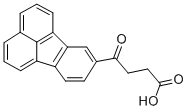Manufacturing Process
50 g of fluoranthene and 26 g of succinic anhydride in 500 cc of nitrobenzene
were treated at 0°C to 5°C with 75 g of anhydrous aluminum chloride. The
temperature was held at 0°C for 4 hours and then allowed gradually to come
to room temperature. The reaction mixture was allowed to stand for 16 hours.
The reaction mixture was then worked up. In so doing, the reaction mixture
was decomposed with dilute HCl, the nitrobenzene was removed by steam
distillation and the residue after filtration was dissolved in hot sodium
carbonate solution and filtered free of a small amount of nonacidic material.
Precipitation from solution with HCl gave a light yellow product which
crystallized from a 50-50 mixture of dioxane alcohol as fine platelets which
melted at 192°C to 194°C and showed a neutral equivalent of 308 which
corresponds closely to the theoretical value of 302 for β-fluoranthoylpropionic
acid.
25 g of the crude acid was dissolved in 100 cc of water containing 13 g of
sodium carbonate. On cooling a thick syrup was obtained. On dilution to 1
liter precipitation started and after standing 16 hours, the solid which
separated was filtered (filtrate treated as below), suspended in water, acidified
with HCl and filtered. Crystallization from alcohol gave a light yellow material
melting at 199°C to 200°C and having a neutral equivalent of 303.
The filtrate mentioned above, upon acidification thereof with HCl gave a
darker acid which melted over a wide range, but had a neutral equivalent
which also corresponds to that of β-fluoranthoylpropionic acid.
